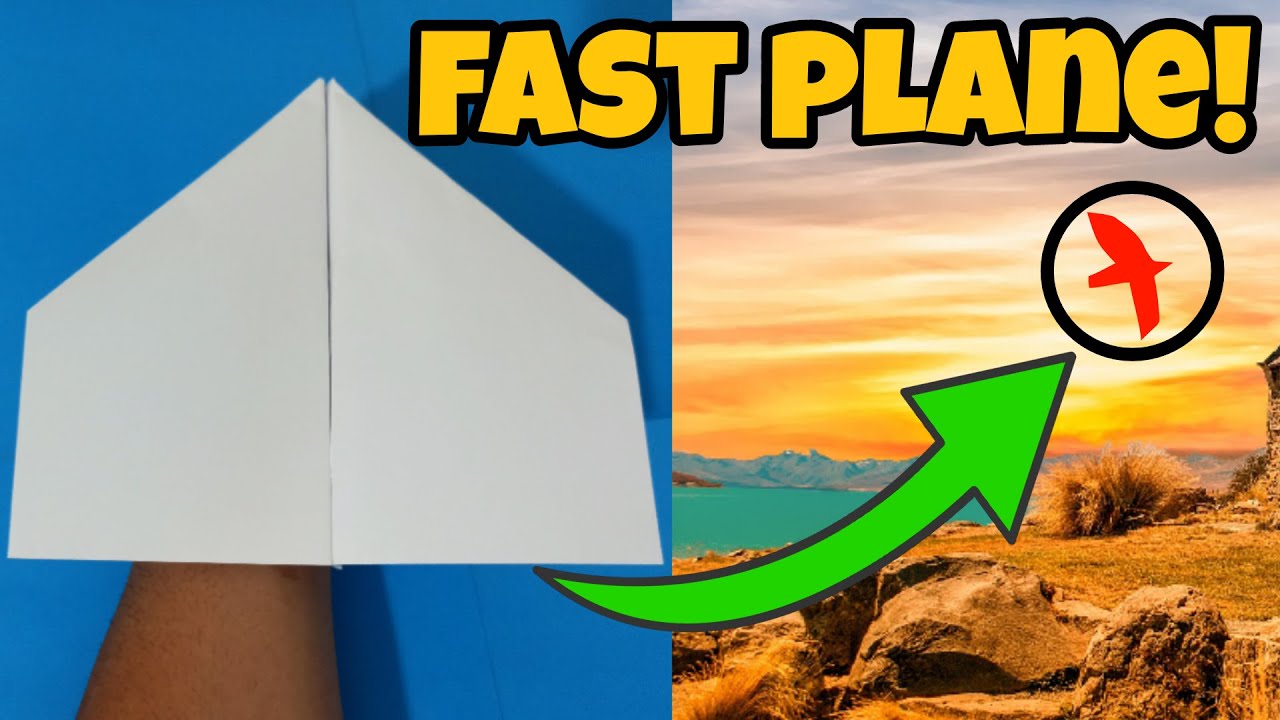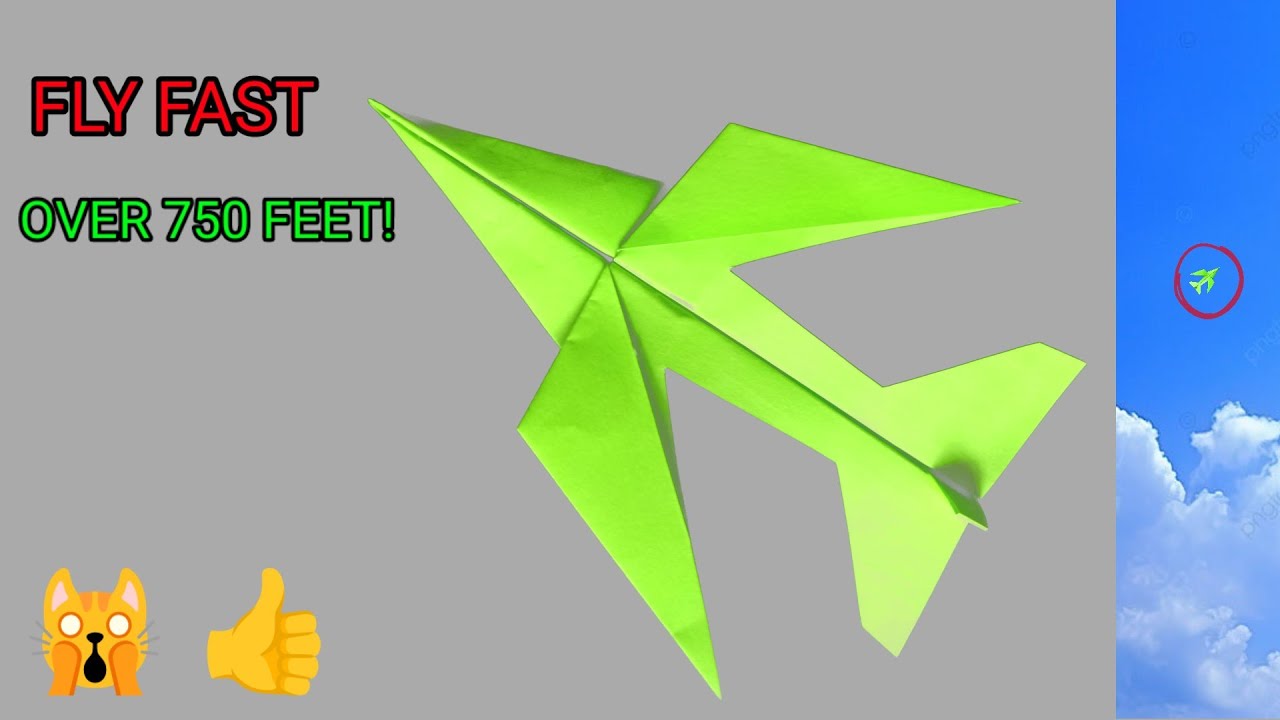Welcome to the exciting world of paper planes! Whether you’re looking to impress your friends or simply want to unwind with a fun crafting project, making a paper plane is a fantastic way to get started. With just a few folds and some creativity, you can create a plane that soars through the air. This guide, inspired by Dailymotion's crafting tips, will help you craft a paper plane that not only looks great but flies far. Ready to spread your wings? Let’s dive in!
The Science Behind Flight

Ever wondered why some paper planes fly better than others? It all comes down to a few fundamental principles of flight! Understanding these can help you tweak your design and maximize your plane's distance. Here are the key concepts you need to know:
- Lift: This is the force that allows your plane to rise into the air. For paper planes, lift is generated primarily because of the wing shape and the angle at which it is thrown. A well-designed wing can catch the air and create enough lift to keep your plane flying.
- Thrust: This is the forward force that propels your paper plane through the air. When you throw the plane, you provide the thrust. The harder you throw, the more thrust you generate! However, it’s not just about power; technique matters too.
- Drag: As your paper plane moves through the air, it encounters resistance known as drag. This force slows the plane down. To minimize drag, make sure your plane is smooth and streamlined. Avoid rough edges or unnecessary flaps.
- Gravity: This force pulls everything towards the Earth. Once you throw your paper plane, gravity will start to pull it down. The key is to balance the lift you generate with gravity to achieve a longer flight.
Design Matters: The shape and structure of your plane can significantly affect these forces. For example, a plane with a wider wingspan can generate more lift, while a heavier body can increase the drag. Experimenting with different designs can lead to surprising results!
Angle of Launch: The angle at which you throw your plane also plays a crucial role. A slight upward angle can help utilize lift effectively, while a flat throw may cause your plane to dive prematurely. Play around with different angles to see how it impacts your flight distance.
So, the next time you fold a paper plane, remember these principles of flight! By understanding how lift, thrust, drag, and gravity work together, you can fine-tune your designs for maximum distance. With a little practice, you'll soon be sending your paper planes soaring across the room!
Also Read This: How to Change Your Dailymotion Icon and Personalize Your Profile with Ease
3. Materials Needed for Crafting Your Plane

Before diving into the world of paper plane creation, let’s gather some essential materials. Don’t worry; you won’t need a treasure trove of supplies! Here’s what you need:
- Paper: A standard A4 or letter-sized sheet works perfectly. You can use regular printer paper or get creative with colored paper for a fun twist.
- Ruler: A ruler helps in making precise folds and measurements.
- Pencil: Optional, but useful for marking fold lines if you prefer a guide.
- Scissors: While not always necessary, scissors can help you customize your plane if you want to trim the wings or body.
- Marker or Stickers: Add some personality to your plane by decorating it once you’ve crafted it!
Having these materials handy will set you up for success. Remember, the quality of your paper can affect the plane's flight. Thicker paper might give you more weight but can also reduce flexibility, while lighter paper can soar but might be less sturdy. Choose what feels right for your crafting adventure!
Also Read This: Understanding the Dailymotion Website Overview of Its Features and Content
4. Step-by-Step Instructions to Fold Your Paper Plane
Alright, let’s get to the fun part! Follow these easy steps to fold a classic paper plane that’s designed for distance:
- Start with a Flat Sheet: Lay your paper flat on a clean, hard surface. Make sure it’s oriented so that the longer side is facing you.
- Fold the Paper in Half: Take the top edge and fold it down to the bottom edge, creating a crease down the center. This will act as your guide for the next folds. Unfold it to reveal a center crease.
- Create the Nose: Take the top corners and fold them down towards the center crease, forming a triangle at the top. Press down to ensure the folds are sharp.
- Form the Wings: Now, fold the triangle you just created down so that the top of the triangle meets the bottom edge of the paper. This should create a more elongated shape. Next, take the top edges (which are now the sides of your triangle) and fold them down to meet the bottom edge, creating your wings.
- Adjust Wing Angle: To ensure your plane flies straight, you can slightly bend the wings upwards. This creates lift and stability.
- Final Touches: If you want to add some flair, decorate your plane with markers or stickers. You can also make slight adjustments to the wings or body for different flight patterns.
And there you have it! Your paper plane is ready to take flight. Remember, practice makes perfect. You can tweak the folds to see how it affects the plane's distance and stability. Happy flying!
Also Read This: How to Download Dailymotion Videos on Windows Mobile
5. Tips for Enhancing Distance and Flight Performance
If you want your paper plane to soar like a champion, there are several tips you can follow to enhance its distance and flight performance. Let’s dive into some practical suggestions that can make a world of difference!
- Choose the Right Paper: The type of paper you use can significantly affect your plane’s performance. Lighter papers, like printer paper, are great for gliders, while heavier cardstock can provide more stability.
- Perfect Your Folds: Precision is key! Ensure your folds are sharp and symmetrical. Use a ruler or a straight edge to help achieve clean lines. A well-folded plane will fly straighter and farther.
- Adjust Wing Shape: Experiment with wing designs. Wider wings can help with lift, but too much wing area can create drag. Try different shapes—like dihedral wings—for better stability and distance.
- Balance is Essential: Make sure your plane is balanced. If it leans to one side, it will veer off course. You can adjust the weight by adding small paper clips to the nose or tail to find the sweet spot.
- Test and Tweak: Don’t be afraid to test your plane and make adjustments. Small changes can lead to big improvements. Try flying your plane in different conditions—indoors, outdoors, with a slight breeze—and see how it performs.
By incorporating these tips, you’ll be setting yourself up for paper plane success. Remember, practice makes perfect, so keep experimenting until you find the ideal combination that works for you!
Also Read This: How Long Does Encoding Take on Dailymotion
6. Common Mistakes to Avoid When Making Paper Planes
Even seasoned paper plane enthusiasts make mistakes now and then. To ensure your crafting experience is smooth and successful, here are some common pitfalls to watch out for:
- Ignoring the Scale: When following designs, make sure to scale your measurements correctly. A small error in size can lead to a poorly flying plane.
- Overlooking Weight Distribution: If your plane is too heavy at the front or back, it won’t fly well. Always check the weight distribution and adjust as needed.
- Folding in the Wrong Direction: Double-check your folding directions. A simple mistake can change the entire stability and aerodynamics of your plane.
- Neglecting to Test Flight: Don’t skip the testing phase! Fly your plane a few times to see how it performs. Making adjustments after each test can lead to greater improvements.
- Sticking to One Design: While it’s great to have a favorite design, be open to experimenting with new styles. You might discover a new favorite that flies even farther!
Avoiding these common mistakes will not only enhance your crafting experience but also improve the performance of your paper planes. Remember, every plane is a learning opportunity, so embrace the process and enjoy the flight!
Also Read This: Troubleshooting Dailymotion – Why Is It Down and How to Fix It
7. Fun Variations to Try with Your Paper Plane Designs
If you think all paper planes are created equal, think again! There are countless fun variations you can try to give your planes unique flying characteristics and styles. Here are some creative ideas to spark your imagination:
- The Glider: This design emphasizes long-distance flight. Fold your paper to create larger wings for better lift. Test it out in an open area and watch it soar!
- The Stunt Plane: Want to impress your friends? Add some twists and turns to your design. Incorporate winglets at the tips for improved maneuverability, and see how many loops you can make!
- The Stealth Bomber: For a more aerodynamic shape, try shaping your paper into a sleek, narrow plane. This will help it slice through the air beautifully and fly farther. Paint it black for an extra cool factor!
- The Delta Wing: This triangular design is not only visually striking but also performs well in the air. Fold the paper into a triangle shape, and you’ll have a plane that’s both stylish and functional.
- The Bi-Plane: Stack two paper planes together to create a bi-plane effect. This design has double the wings, which can increase lift and stability. Plus, it looks super cool!
Don't be afraid to experiment with different paper types too! Using heavier paper can give your planes more durability, while lighter paper might help them fly higher. Try colored paper or even patterned sheets to add a personal touch. The more variations you explore, the more you’ll discover what works best for your flying style.
And let’s not forget about decorating! Use markers, stickers, or washi tape to customize your planes. You can even create themed planes for different occasions—like a holiday design or a sports team logo. Get creative and let your personality shine through your paper planes!
8. Conclusion and Encouragement to Experiment
Congratulations! You've now got all the fundamentals to make a paper plane that flies far, along with exciting variations to try out. The joy of crafting and flying paper planes is about more than just getting them to soar; it’s about the fun you have along the way!
I encourage you to gather your family and friends for a paper plane competition, where you can showcase your newly crafted designs. Set up challenges like longest flight, best tricks, or most creative design. This can be a fantastic way to bond and make unforgettable memories!
Remember, the sky's the limit! Don’t hesitate to modify your designs and test new ideas. Maybe you’ll come up with a revolutionary paper plane that flies farther than anything we’ve seen before. Keep experimenting, and who knows—you might just spark a new trend in the world of paper aviation!
So, grab your paper, start folding, and let your imagination take flight. Happy crafting!
 admin
admin








